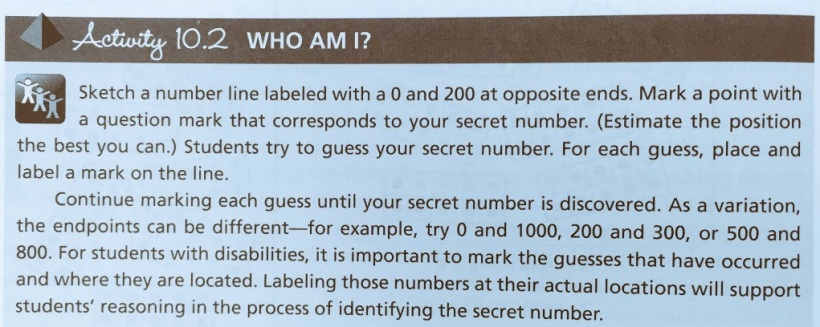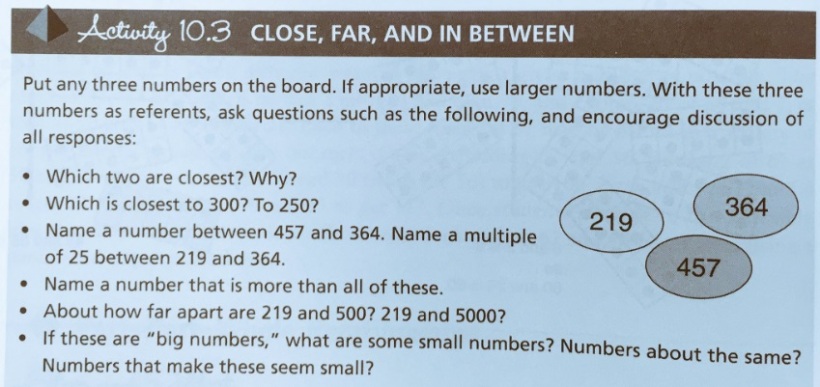In the last few weeks I have asked several groups of teachers to indicate where 1 billion would go on this number line:
It has been really interesting to me that many have placed the 1 billion mark in a variety of areas and have had a variety of reasons why. Many have attempted to use their understanding of place value digits (there are 12 zeros in 1 trillion and only 9 zeros in 1 billion, so 1 billion should be 3/4 of the way toward a trillion) or their knowledge of prefixes to help (million, billion, trillion… so it must be 2/3 the way along the line). Others thought about how many billions are in a trillion asking themselves, “Is their one-hundred or one-thousand billions in a trillion?” Using this strategy, everyone picked a spot toward the left, but some much closer to zero than others.
Others did something interesting though. They started placing other numbers on the number line to help them make sense of the question. Often placing 500 billion in the middle, then 250 billion at the 1/4 mark and so on until they realized just how close to 0 a billion is when we are considering 1 trillion.
What’s the point?
Really big numbers, and really small numbers (decimal numbers), are difficult to conceptualize! They are hard to imagine their size! Think about this:
How long is 1 million seconds? Without doing ANY calculations would you guess the answer is several minutes, hours, days, weeks, months, years, decades, centuries…? Can you even imagine a million seconds without calculating anything?
How about 1 billion seconds? Or 1 trillion seconds?
I bet you’ve started trying to calculate right! That’s because these numbers are so abstract for us that we can’t imagine them.
Because of this little experiment, I am left wondering three things:
- What numbers can/can’t the students in our classrooms conceptualize?
- What practices do we do that gets kids to think about digits more than magnitude?
- What practices could/should we be including that helps our students make these connections?
What numbers can/can’t the students in our classrooms conceptualize?
Before we start working with operations of any given size, I think we need to spend time making sure our students can visualize and estimate the size of the number. Working with numbers we can’t imagine doesn’t seem productive for our young students! In our rush to move our kids into more “complicated” mathematics, we often move too quickly through numbers to include numbers that are too abstract for our students! We think that if a student can accurately carry out a procedure that they understand the numbers they are working with. However, I’m sure we have all seen many students who produce answers that are completely unreasonable without them noticing. Is this carelessness, or is it a lack of understanding of the magnitude of the numbers involved? Or possibly that our students aren’t visualizing the size of and relationship between the numbers???
What practices do we do that gets kids to think about digits more than magnitude?
The other day, Jamie Garner shared her frustration on Twitter:

Think about the question from the textbook for a second. Students trying to think about 342 pencils (not sure why they would want that many) should be considering a strategy that makes sense. For example, if you had 342 pencils how many boxes of 10 would that be? Thinking this way, student should answer 34 or 34.2, or maybe 35 boxes (if you wanted to purchase enough boxes). However, the teacher’s edition tells us that none of these are the right answer. Take a look:

If our students attempt to make sense of the problem, they will be completely wrong! In fact, many students will likely answer 4 because they’ve been trained not to think at all about the mathematics, and instead focus their attention on what they think the text wants them to do.
This is one of MANY cases where elementary mathematics focuses on digits over understanding magnitude or relative size. Here are a few others:
These, along with pretty much any standard algorithm (see Christopher Danielson’s post: Standard Algorithms Unteach Place Value) tell our kids to stop thinking about what makes sense, and instead focus on steps that help kids get an answer without understanding.
What practices could/should we be including that helps our students make these connections?
If we want our students to understand numbers, and their relative size… if we want to help our students develop a conceptual understanding of operations… if we want our students make sense of the math they are learning… then we need to:
- Use contexts that make sense to our students (not pseudo-contexts like the pencil question above).
- Provide plenty of experiences where students are making sense of numbers visually. When we allow our students to access their Spatial Reasoning we are allowing them to see the relationship between numbers and help them make connections between concepts.
- Provide plenty of experiences estimating with numbers
Below are 2 activities taken from Van de Walle’s Student Centered Mathematics. Think about how you could adapt these to work with numbers your students are starting to explore (really big or really small numbers).


A few questions for you to reflect on:
- How might you see how well your students understand the numbers that are really large or really small?
- How are you helping your students develop reasonableness when working with numbers?
- What visuals are you using in your class that help your students visualize the numbers you are working with?
- What practices do you use regularly that help with any of the 3 above?
P.S. Here are the answers to the seconds problem I posted earlier:



Take a look at IsThatABigNumber.com.
Lots of ways to visualise big numbers and build number sense.
LikeLike
Hello! This post was recommended for The Best of the Math Teacher Blogs 2016: a collection of people’s favorite blog posts of the year. We would like to publish an edited volume of the posts at the end of the year and use the money raised toward a scholarship for TMC. Please let us know by responding via http://goo.gl/forms/LLURZ4GOsQ whether or not you grant us permission to include your post. Thank you, Tina and Lani.
LikeLiked by 1 person
Hi! This is great stuff–lots of good ideas and advice. The general idea of paying attention to how people cope with magnitudes outside of everyday experience is important and valuable.
But I have one caution/concern: it’s not obvious that people really *can* conceptualize these magnitudes, and so putting them in context may or may not help. My lab has been doing research on numbers in the billions and trillions for about 8 years. After all this time, we *still* can’t answer questions like “how long would a million human hairs be, laid width-wise?”, or “how long is a trillion seconds?” We just have no intuition for these numbers.
More formally, Tretter(1) has pointed out that professional chemists and others who work in these contexts mostly use scales to reduce numbers to pretty small, everyday ones–just in unusual scales. We’ve found(2) that even people who succeed at the number line task do it mostly by paying attention to the numerals and their structure. That is, we don’t really end up using context/reasoning as much as we might think–we get really good at using the numerals in appropriate ways.
My point is this: it’s *great* to try to put numbers in context (3), and use common sense, and make connections. But a naïve reader might come away thinking you’re wholly decrying focusing on digits, and doing intra-symbolic sense-making. Let’s recognize that this kind of patterning is a crucial and valuable part of mathematical thinking, that sits alongside and supports other kinds of thinking. It’s not like one is ‘understanding’ and the other is not. Indeed, in the case of large numbers, getting answers without really getting what we’re talking about is probably exactly what we want to be become good at.
(1) Tretter, T. R., Jones, M. G., Andre, T., Negishi, A., & Minogue, J. (2006). Conceptual boundaries and distances: Students’ and experts’ concepts of the scale of scientific phenomena. Journal of research in science teaching, 43(3), 282-319. https://scholar.google.com/scholar?cluster=16546501758574570865&hl=en&as_sdt=0,15
(2) Landy, D., Silbert, N., & Goldin, A. (2013). Estimating large numbers. Cognitive science, 37(5), 775-799. http://davidlandy.net/wp-content/uploads/2013/06/Landy_Silbert_Goldin_OP2013.pdf
(3) Barrio, P. J., Goldstein, D. G., & Hofman, J. M. (2016, May). Improving Comprehension of Numbers in the News. In Association for Computing Machinery Conference on Human Factors in Computing Systems, San Jose, CA (May 7–12). http://www.cs.columbia.edu/~pjbarrio/papers/numeracy.pdf
LikeLike
Great comment. In the introduction I started with the number 1 trillion hoping that we would recognize how difficult large numbers really are. My focus, however, isn’t with numbers of this size, but with our young students experiencing any new size of number. For example a grade 3 student might have many experiences with numbers from 1 to 100, but numbers to 1000 are new. I am advocating that our students need a variety of experiences to understand a number like this. Solely focussing on digits isn’t productive. But I agree, solely focussing on a number line or solely focussing with contexts might not be productive either. Our students need multiple varied experiences to help them build a relational understanding. At this age it is extremely important that students can think flexibly about numbers. I want students to recognize that A number like 123 can be thought of as having one 100, 2 10s, and three ones. But also that 123 has 12 tens and 3 ones. This understanding helps our students with metric conversions, with regrouping, making sense of multiplication algorithms…
I’m not sure, but it sounds like much of your research is with students will beyond what I’m talking about here. I’ll take a look at your research soon.
LikeLike
For visuals of large numbers I love Montessori. Intro to decimal tray and then the hierarchical material. Oh, that they had material that goes to a trillion out in a park or museum somewhere.
http://pin.it/08aIny-
LikeLike
Reblogged this on TES Math Lab.
LikeLike